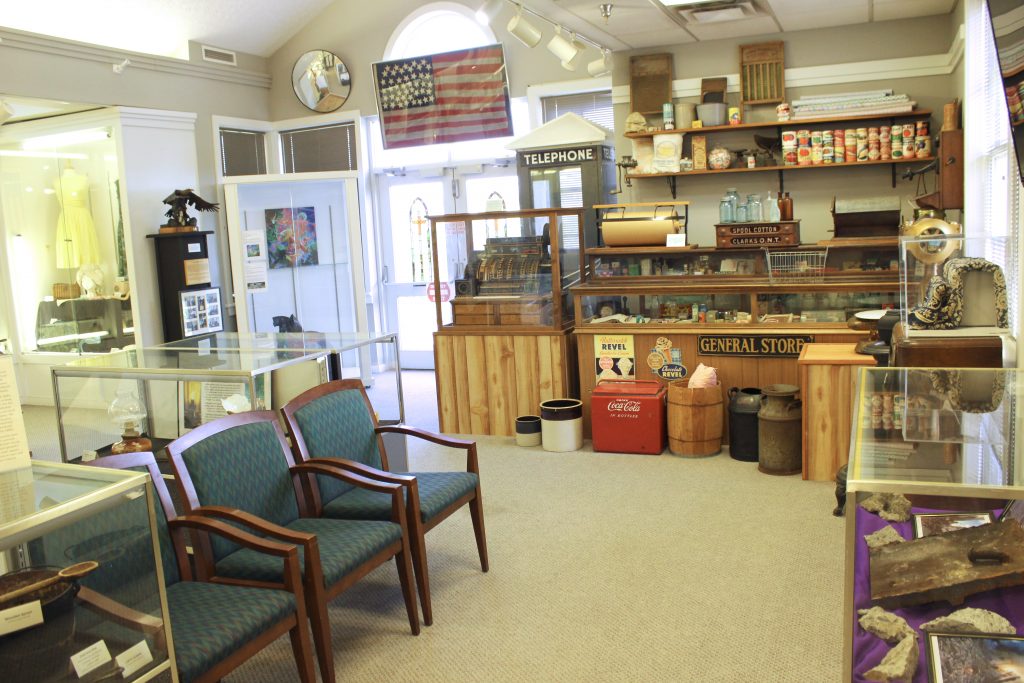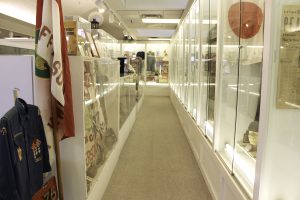Writer / Beth Wilder, Jeffersontown Historical Museum Director
In 1965, Jeffersontown city leaders were interested in having an overall Colonial-style look for the town, so a Restoration Society was formed as a committee of the Chamber of Commerce, “for the express purpose of restoring Jeffersontown in keeping with its heritage.”
A “Williamsburg-style” City Hall was constructed, and city leaders tried to get other businesses on Jeffersontown’s square to either build in similar style, or create facades for their buildings to give a more cohesive appearance.
Jeffersontown, at the time, was approaching its 175th anniversary, so then Mayor Franklin Chambers was hoping to provide residents with a museum to preserve and showcase aspects of the city’s history. Meanwhile, the Woman’s Club and a few other residents had formed a rather loose-knit historical society to try to locate historic artifacts related to Jeffersontown, in order to preserve them. One of their first orders of business was to have all the 1907-1912 Jeffersonian newspapers put on microfilm.
They also managed to secure an 18’ x 20’ room on the second floor of City Hall in which to display the few small artifacts and documents that had been donated.
By the time of Jeffersontown’s September 1972 anniversary party, the museum in City Hall was nowhere near complete, but residents at least had the opportunity to view the artifacts on display there. Volunteers sometimes watched over the exhibits, but Lena Hubbuch, the city clerk, quite often had to lead tours of the newly established museum. In 1973, Virginia Chambers became Curator of the Jeffersontown City Hall Museum. It was at this time that the Jeffersontown and Southeastern Jefferson County Historical Society was officially launched in January with 40 members. By December, membership had grown to 123.
The Society, which met on the upper floor of the Jeffersontown Library, believed its major function was to “discover and collect any material which may help to establish or illustrate the history of the area,” and to “provide for the preservation of such material and for its accessibility to all who wish to examine or study it.”
Because the City Hall Museum was not as accessible to the public as had been originally hoped, visitation dwindled, and 1975 was the last date recorded in the museum’s visitor register. In 1982, the Historical Society considered moving the artifacts to the upper floor of the library, but that building, which once housed residents of the Jefferson County Poor Farm, was quickly growing decrepit, with water leakage, sagging floors and no handicap accessibility. The historic artifacts were put into storage at City Hall, until a new home could be found for them.
In 1994, the Jeffersontown Historical Preservation Committee wanted to bring the collection of artifacts back out for public view. Some people wanted the Library to be renovated as a museum, but it was believed at the time that the building was beyond repair, so city leaders intended to construct a new library and museum facility next to the old building (which would later be renovated as the Jeffersontown Senior Citizen’s Center).
On January 29, 1996, the new Jeffersontown Library and Museum held its Grand Opening. Originally, it was believed volunteers interested in local history could operate the museum with cooperation from the Jeffersontown Library staff, but that did not work out as well as hoped.
David Olshansky, Director of Economic Development for Jeffersontown at the time, noted that “the volunteers who envisioned the museum did a remarkable job in helping it happen and running it, but it has reached a point where operating the museum on a daily basis is more demanding to come solely from volunteers.”
Olshansky retired in 1999 and was temporarily replaced by John Cosby, the Director of the Jeffersontown Development Council. That same year, Petra Williams, who along with Peggy Weber, came up with the idea of lining the town square with gaslights in the late 1960s (and creating a “Gaslight Festival” to celebrate the town’s new look), donated her large collection of folk dolls to the City of Jeffersontown. In 2000, Bill Cummings was appointed Museum Director, and a new renovation took place to make room for the doll collection, as well as the historical Jeffersontown artifacts.
The museum garnered a great deal of publicity nationwide for its doll collection, but it was primarily focused on Jeffersontown’s history. The City of Jeffersontown hired two more people to help with the Museum — Ester Harlow, Assistant Curator of Education, and Beth Wilder, Curator and Archivist. Bill Cummings, unfortunately, passed away in 2004, and Beth Wilder was then appointed Director to replace him.
More recently, Rhonda Rowland was hired as Arts Program Manager, part of which includes promoting the Jeffersontown Historical Museum.
After Bill Dieruf became Mayor in 2011, he and the Town Council set about updating the City of Jeffersontown web site. Part of their vision for bringing the city into the internet age was to include the town’s history on the city website as well. Several pages were dedicated to history preserved at the Jeffersontown Historical Museum, and a major undertaking involved digitizing the Museum’s archives of old Jeffersonian newspapers, which are still available for viewing at jeffersontownky.gov.
Thanks to the efforts of countless individuals, the Jeffersontown Historical Museum is still going strong, working to preserve information and artifacts pertinent to Jeffersontown’s history. We are always on the lookout for items related to Jeffersontown’s past, the genealogy of its founding families and photographs of the town.
If you are interested in donating items to the Museum, or allow us to scan old Jeffersontown photos, please contact Beth Wilder at 502-261-8290 or bwilder@jeffersontownky.gov. And don’t forget to visit us at the museum and see what you’ve been missing all these years!

Museums are known for preserving history, but have you ever considered the fact that museums themselves also have a history? The Jeffersontown Historical Museum, located at 10635 Watterson Trail, has been going strong at its present location since 1996, but its roots go back much further.
 City Leaders listened to Olshansky and included a full-time museum director in the 1997 budget, and Olshansky himself was chosen to become the Jeffersontown Historical Museum’s first Director. Since 1997 also happened to be Jeffersontown’s Bicentennial, there was a renewed interest in the city’s history and museum, so Olshansky worked tirelessly to renovate the museum into a showcase for the city. He used his skill at woodworking to create many of the displays himself and even earned awards for the state’s best new museum.
City Leaders listened to Olshansky and included a full-time museum director in the 1997 budget, and Olshansky himself was chosen to become the Jeffersontown Historical Museum’s first Director. Since 1997 also happened to be Jeffersontown’s Bicentennial, there was a renewed interest in the city’s history and museum, so Olshansky worked tirelessly to renovate the museum into a showcase for the city. He used his skill at woodworking to create many of the displays himself and even earned awards for the state’s best new museum.







Comments 3